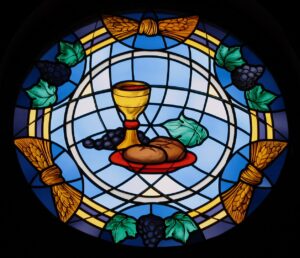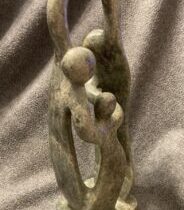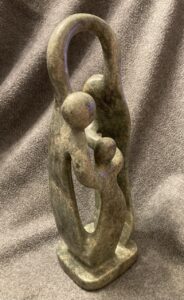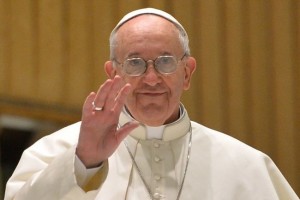 Families today are struggling with the challenge to fit in a day all the things they need to do. School, childcare, meals, commute, work, marriage, parenting, pets, athletics, extended family, finances, church, house, local and broader civic issues, friends, medical needs, and recreation all require thought and planning. Everyone wants their children to be happy and, for parents with faith, this includes wanting their children to be close to God, part of a community of believers, and to have a faith-filled life.
Families today are struggling with the challenge to fit in a day all the things they need to do. School, childcare, meals, commute, work, marriage, parenting, pets, athletics, extended family, finances, church, house, local and broader civic issues, friends, medical needs, and recreation all require thought and planning. Everyone wants their children to be happy and, for parents with faith, this includes wanting their children to be close to God, part of a community of believers, and to have a faith-filled life.
Parenting Styles
Usually families adopt some form of three parenting styles: Authoritarian, Permissive or Dialogue. The style used may vary based on situation and/or age of the child.
Some rules, such as “No running into the street,” start out as authoritarian with a very young child but with older children there can be a dialogue about the reasons. Brushing a two-year-old’s teeth is a decision from the top down (authoritarian). Later on there can be conversations about it. Permissive parenting, in which the children run the house and are allowed to break the rules or to not do the chores is usually never helpful. At times, when a child has exams, she can skip her chores or go to bed late, but that can be decided in a negotiation about the special situation. Going to church for parents with faith will be at the top of the hierarchy of choices about the family schedule. Hopefully the parents know that they need to be there — to hear the Scriptures, the preaching, or to receive the Eucharist. There may be exceptions, but being consistent will make the liturgy a natural and essential part of the rhythm of life. Church can also be a place for other involvements for children, such as religious education, roles in the liturgy, youth group, outreach, or choir. Making the liturgy more meaningful for children by providing a book to read or color can also help them engage in the Mass and enjoy it more.
But all of this will not necessarily help children to have a relationship with God or stay in the Church. A big help in this direction is if the parents have a living relationship with God, can naturally talk about it, and enjoy spending time with their children. The best approach is both organic to the parents’ entire orientation and planned strategies. Parents who know and experience God and the saints in their lives think, feel and do everything out of a spiritual orientation and discernment. In their adult relationships, home/family, work, and the world, everything hopefully is referred to God and what God is loving for them to love (even learning to trust him in little things like losing your keys). Feelings and actions that come from fear can be recognized and given to God (Discernment). If a parent grows in discernment and asks for wisdom and courage, God will give it and everything goes much better. Planning, conversations, and family problems — all are more productive. Everyone in the family can grow in peace, understanding, generosity and trust in God.
Stress and worry are a part of family life. Painful things will happen. Feeling loved by God will not prevent or remove all suffering. It will reduce anxiety and even anger. For the faith-filled family, unavoidable forms of suffering can be understood as a sharing in Jesus’ redemptive work in the world. (Mk. 10:44 ff.) We also know that he never leaves us. He asks us to lean on him and ask him for the grace to bear the heavier loads. Daily prayer — both talking to God and listening to God — can help parents to keep perspective and not take personally the problems that will come. (For work and faith ideas, see: Heroic Leadership by Chris Lowney, Loyola Press: Chicago, 2005. Excellent, well written.)
Protecting Children, then Letting Them Go
One of the biggest issues that comes up in child-raising is that of control. Parents are responsible for working through the process of protecting their children and then letting go of them. Parents pour love, energy, resources, and sacrifices into family life but do not “own” their children, who in fact are gifts from God. At some point, offspring will start making their own decisions and these may not reflect the values of the parents. They may have abilities and desires that are foreign to the parents. There will be a period of time when children are learning who they are and trying out many experiences available to them. If the child has been exposed to a healthy and holy way of dealing with decisions (e.g. trust in God and discernment) in the family from infancy, they have a very good chance of seeking what God wants for them.
Adults and children can develop an interior life with God in which they recognize when they are doing actions from fear, insecurity, laziness, and/or to impress others. Children encounter many negative things in their lives both in themselves and others. Bullying, cheating, and lying are all around them. There is no harm is letting them know about the influence of the Evil Spirit too when they are older. In middle school they will encounter many forms of social climbing and meanness right next to kindness and generosity. Parents can spend time by both listening to the child and talking about the fact that God will be with them as they make the choice to be friendly to an outcast or to own up to a bad choice.
Understanding the developmental stage of your child is important for both their moral understanding and experience of faith. The work of the religious psychologist Dr. James Fowler is very helpful. His work is summarized in an article entitled “How God Invites Us to Grow: the Six Stages of Faith Development” by Richard J. Sweeney, Franciscan Media, Catholic Update, No. CU1087.
Discernment as Part of Family Life
God dwells within us and will help us sort out destructive feelings from those of courage, strength, hope, and self-worth. If parents are doing this themselves day after day and sharing this at times with their family, the children will share their successes in being strong and discerning too. Listening to our kids, wanting to know their interests and worries, will help them to feel understood. The goal is not control. The goal is that we surrender to God our desires, worries, and problems and let him tell us how best to work with them. The prayer of St. Ignatius of Loyola called The Examen is very helpful in going over each day what is working and not working in my thoughts and behaviors and what I can ask God to help me with. There are many modern versions of this prayer available. Children can be taught to do this little review without dwelling on the mistakes but simply asking Jesus to be there when I am feeling pressure.
It is not by accident that our present Pope Francis speaks constantly of dialogue and seeking understanding. According to Francis, we should never be frightened of being open to understanding those who disagreed with us. (Pope Francis, homily October 4 in the Mass opening the Synod on the family, St. Peter’s Basilica) To the pope that does not mean that we cannot condemn certain philosophies and behaviors, but it does mean that we must understand and love others no matter what. Once we surrender our lives and our children’s lives to God, we can expect and ask God to help us. (E.g. blind Bartimaeus, Mk. 10:46-52) In his encyclical, Laudato Si, Pope Francis points out that in creating a new human ecology in which we all nurture the Earth, marriage and family are a natural base for this kind of universal solidarity. The self-giving of marriage can be taught to children, who can learn to care for the Earth and share its resources with others. Parents and children can forge a strong bond while living these values together. Parents can communicate the ways in which God reveals his love in the beauty, mystery and rhythms of Creation.
Practical Suggestions
Some practical suggestions for family life are to selectively sprinkle in your talk how you react to problems or make decisions out of your relationship with God, find times for family prayer, and ask your kids individually how things are going. One time for prayer is before dinner. Take a little time to ask people at the table if there is someone or something they would like everyone to prayer for. This can also be a bedtime ritual. It is great if parents purchase appropriate lives of the saints and read parts to younger children each night, etc. Acknowledging to a child that you know they have a concern: an exam, tryouts for a sport, a difficult subject at school, a dance coming up and saying, “I’ll pray for you,” is a good thing if it is not constant. Children are very perceptive. If you are sincere and are seeking God, they will be too. But, if God is abstract for you, children will sense this. You might consider seeing if there is a spiritual director in your parish to talk to or a retreat center in the area where you can go on a retreat, spend a few hours, or see a spiritual director. There are also wonderful websites to visit regularly, even for just 10 minutes, that have articles, mini-retreats and music. A wonderful article on prayer, “Never Lose Heart” by Robert P. Maloney, CM, for example, is found on the America Magazine website.
Discussion (or Reflection) Questions
1. Have I experienced God or the saints ? In what ways?
2. Do I pray? What kinds of prayer am I familiar with? Speaking and listening?
3. Can I share my faith or thoughts about spiritual things in a natural way or is this difficult?
Image: “Woman and Child” – Renoir – public domain
Read More
 Happy Feast of Corpus Christi (Feast of the Body and Blood of Christ) weekend! I’m writing to my spiritual family today and thought of my own birth family as well.
Happy Feast of Corpus Christi (Feast of the Body and Blood of Christ) weekend! I’m writing to my spiritual family today and thought of my own birth family as well.












 Like many of you, I received a chain email from a friend about the moral imperative to support pro-life candidates. The email was basically an endorsement of Donald Trump including the statement that no Catholic could in good conscience support Hillary Clinton.
Like many of you, I received a chain email from a friend about the moral imperative to support pro-life candidates. The email was basically an endorsement of Donald Trump including the statement that no Catholic could in good conscience support Hillary Clinton.












